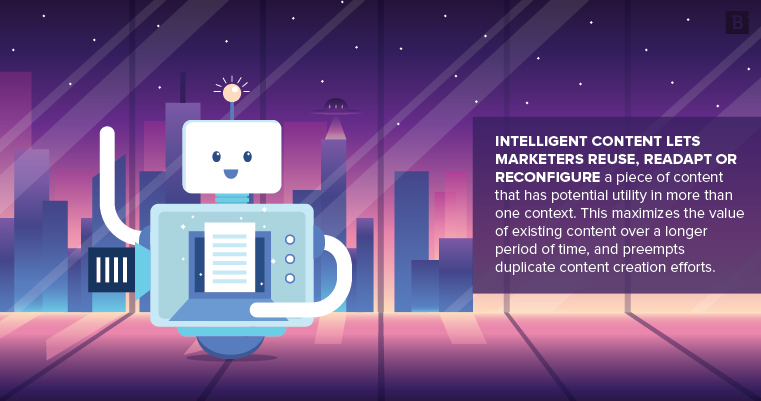Ever hear the saying “create once, publish everywhere”?
Content creators borrowed this from the Java coding language’s mantra of “write once, run anywhere,” or WORA. The idea is that you code a program once and then reuse it on any operating system.
Intelligent content is the content equivalent of WORA. It refers to highly structured and contextualized text, images and videos that humans and machines can reuse and reconfigure.
Intelligent content is so precisely structured that entirely new assets can be created through fragments (individual paragraphs and headers, images, videos, etc.) of already-existing assets.
It’s a cool idea, and as we’ll explain, it certainly won’t work as a universal content creation template.
Nevertheless, intelligent content is already a reality for many organizations, and it may just be the most efficient way to future-proof your content marketing strategy.
Characteristics of intelligent content
Intelligent content is first and foremost a practice, and to understand that practice, you first have to understand the three core characteristics that define a piece of content as “intelligent.”
These are:
- Structure: Narratively speaking, landing pages, white papers, blog posts and other assets must be structured so that each section answers specific questions for a predefined audience. This is generally best practice since it makes content scannable for a human reader. For the purposes of intelligent content, structure is also important for making it machine-readable, which we’ll explain in just a moment.
- Modularity: Different sections within a structured piece of content can theoretically have relevance outside of the original context. Think of it like stock photography. The same image of a man smiling in front of a phone could be used to convey more than one idea. Even if that photo was initially captured with a particular use in mind, it is still a modular content component that can be plugged in elsewhere.
- Semantically rich: Speaking of which, that stock photo of a man smiling at his phone might have multiple semantic metadata tags implemented within machine-readable text like XML. That is how computers know, for instance, that the image is relevant in multiple contexts. So, when a human user searches “video chat,” “enterprise mobility” or “mobile application user” on a stock photo site, that same image might appear. In text, individual content pages can be organized in metadata “categories” while specific sections might contain “tags” that describe the meaning of the information conveyed. Semantic metadata is, in essence, what distinguishes structured from unstructured content.

So to bring it all together, you have content that is well-structured for human readers by being thematically organized. Since each section has a clear meaning, the content within could ostensibly stand alone in the right context.
The content is also well-structured for machines with rich metadata (literally, data that describes data to a machine), which means you have the theoretical ability to automate content delivery to audiences, and in some cases, automate content creation.
This lends itself to the practice of creating content that is:
- Discoverable: Structuring content with semantic metadata (categories and tags that explain meaning) rather than exclusively using formatting metadata (describes what it is, e.g., a photo, header, a paragraph, etc.) makes content more discoverable based on meaning. This is an important step to enabling the other attributes of intelligent content listed below.
- Reusable: Well-structured and well-defined content can be easily discovered, meaning it can be quickly retrieved for reuse. Content can hereby be manually (copying and pasting) or automatically reused (as part of a CMS workflow feature) in an appropriate context. This saves time and money that might otherwise be spent creating content that already exists. Intelligent content is also easier to translate into multiple languages thanks to its structure.
- Reconfigurable: The benefit of content being modular is that fragmented pieces of a bigger whole can be easily recreated or restructured based on evolving needs, according to Ann Rockley, co-producer of the Intelligent Content Conference.
- Adaptable: Intelligent content can be easily readapted across platforms (e.g., mobile), for multichannel use (web, social, e-mail, etc.) or for specific audiences. It uses information that is made available through other data sources to retrieve and deliver content that is “adapted to your preferences and situation,” according to the Content Marketing Institute.
The end result is the ability to do more marketing with less content creation. Intelligent content lets marketers reuse, readapt or reconfigure a piece of content that has potential utility in more than one context. This maximizes the value of existing content over a longer period of time and preempts duplicate content creation efforts.
Examples of intelligent content
With that in mind, let’s look at a few simple examples of how to work intelligent content into a content marketing strategy:
- A customer asks a chatbot a question that has already been answered elsewhere on your site. That bot’s answer could actually use pre-existing content as a response to that query.
- You’re creating a best-practices email campaign. You quickly search for and collect list-based content that already exists on your blog and use each of those items as a “tip of the day.”
- A conference is coming up for one of the most lucrative industries you serve. You want to create a landing page that lists all of your company’s keynote speakers and provides their background experience, a photo, links to their thought leadership articles and a quick synopsis of what they’ll be discussing. Rather than create this content from scratch, you retrieve the instances where this information already exists and create your new LP in half the time it would normally take.

Think Google, but in your own organization
In a way, this modular repurposing of existing content describes how a search engine works. As anyone who’s read this blog before knows, SEO-driven content marketing is the practice of giving Google the context it needs (through content and metadata) to present cross-format content that aligns with searcher intent and answers specific questions.
The key difference is that search engines use extraordinarily advanced machine-learning processes such as natural language processing to read content (intelligent or otherwise), and can do this only because of the astronomical amount of data they have access to.
The average business has neither the machine-learning muscle nor the ocean of data needed to accomplish this within its own content marketing workflows. But with intelligent content, you don’t need either of those things. The content is inherently structured so that it is easy to find and reuse as needed.
What does this mean for the future of content creation?
By now, you should have a solid sense of what intelligent content is, how it can save money and why it will be so important for optimizing content creation efforts.
So is it future-proof?
Ultimately, we say yes.
Intelligent content is so well-structured and modular that it can be reused and reconfigured many times. So yes, a lot of your intelligent content will have utility in the future and will save you quite a bit of time and money so that you can focus on other marketing functions, ultimately becoming more competitive.

But that does not mean all content will be intelligent in the future.
No template exists for thought leadership content or for marketing collateral that really nails your brand’s shifting values and ever-evolving identity.
In other words, there’s a time and place for intelligent content. It’s great for creating and updating product landing pages and for repurposing content for cross-channel campaigns. But your brand also needs to continue churning out fresh ideas, and to do so in creative new ways if it hopes to capture its audience’s imagination.
So the concept of “create once, publish everywhere” is true. But for the things that have yet to be said, or for the creative avenues for brand expression that remain unexplored, intelligent content has no foreseeable future – at least not yet.
Still, intelligent content frees up marketers to devote more time to creating something new and different, and that’s an undeniable competitive edge.





